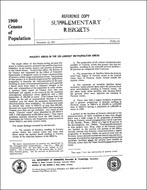1960 Census — Population, Supplementary Reports: Poverty Areas in the 100 Largest Metropolitan Areas
1960 Census — Population, Supplementary Reports: Poverty Areas in the 100 Largest Metropolitan Areas
The major effort of this Nation during the past few years to reduce poverty produced the need for improved statistics on the extent, nature, and location of poverty in the United States. To aid in this effort, the Office of Economic Opportunity asked the Bureau of the Census to designate areas of major concentrations of poverty within large metropolitan areas. The purpose of this project is to identify target areas for antipoverty programs, to describe the characteristics of the poor residing in areas of concentrated poverty, and to provide a benchmark from which to measure changes in the size and composition of the population in urban slums.
A poverty index based on Census tract data was developed and applied to all tracts in the 101 standard metropolitan statistical areas (SMSA's) with a 1960 population of 250,000 or more. No attempt was made to extend this work to SMSA's of less than 250,000, because for many of these smaller SMSA's the necessary Census tract data are not available. As a result of this work, "Poverty Areas” were identified in 100 SMSA's with a 1960 population of 250,000 or more. This report presents selected statistics from the 1960 Census of Population for Poverty and Nonpoverty Areas in each of these SMSA's and their central cities.
The major findings revealed by the data are:
- The number of families residing in Poverty Areas within the central cities was more than three times the number found residing in Poverty Areas in the suburban balance of the SMSA's.
- The proportion of all central city families who resided in Poverty Areas was greater than that for families residing in the suburban poverty pockets-- 30 percent as compared with 9 percent.
- The proportion of families below the poverty level was higher in Poverty Areas of the central cities than in Poverty Areas located outside the central cities.
- The majority of nonwhite families whose economic status placed them above the poverty level were nevertheless residing in Poverty Areas. On the other hand, white families with incomes below the poverty level were typically not residing in Poverty Areas.
- There was both a higher incidence of poverty and a greater proportion of families residing in Poverty Areas in SMSA's of 250,000 to 1,000,000 than in SMSA's having a population of 1,000,000 or more in 1960.
The PDF to the right contains the 24-page report.
A Note on Language
Census statistics date back to 1790 and reflect the growth and change of the United States. Past census reports contain some terms that today’s readers may consider obsolete and inappropriate. As part of our goal to be open and transparent with the public, we are improving access to all Census Bureau original publications and statistics, which serve as a guide to the nation's history.




